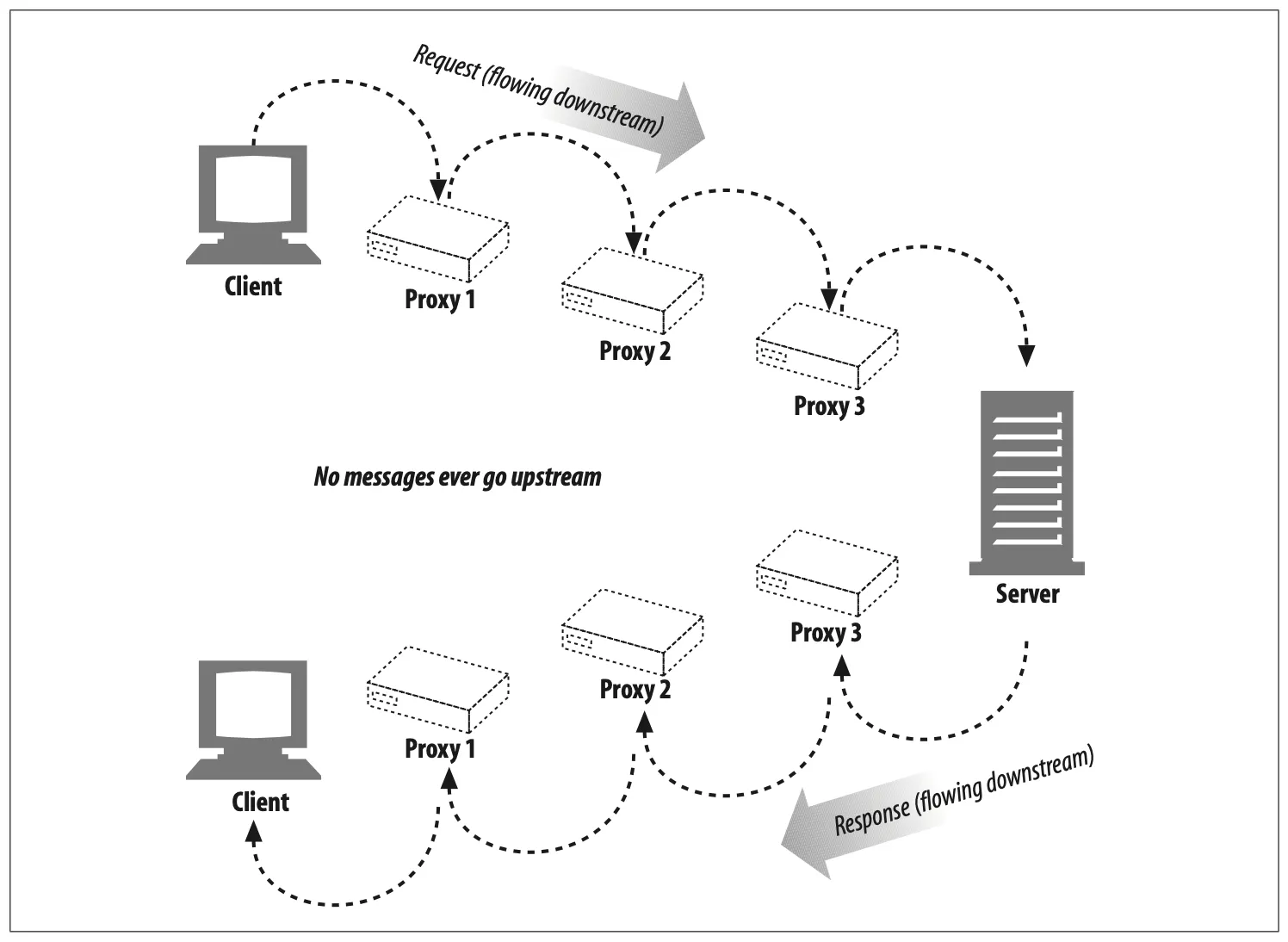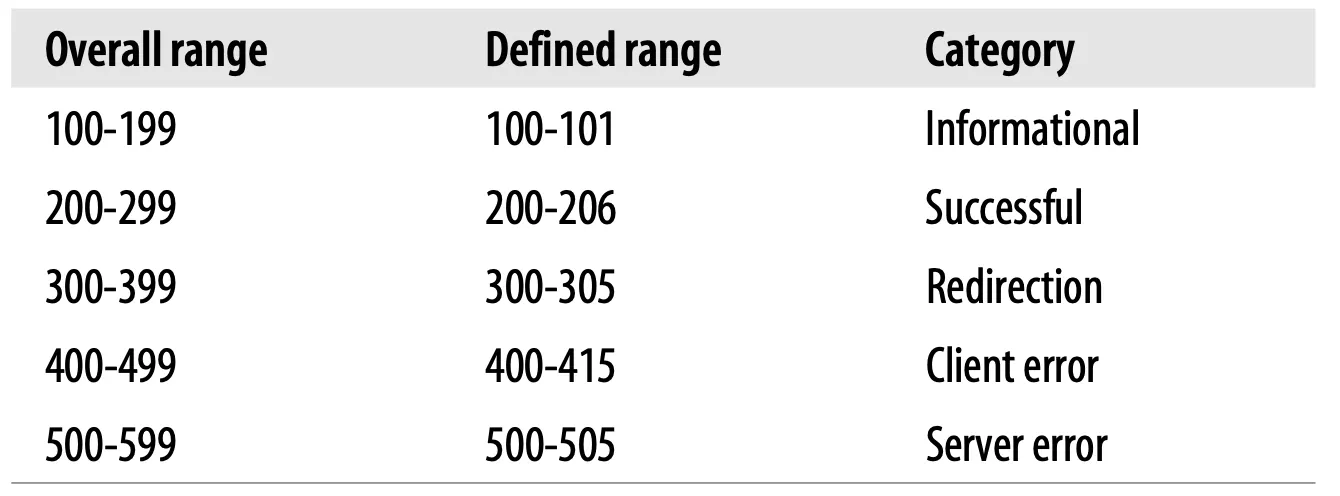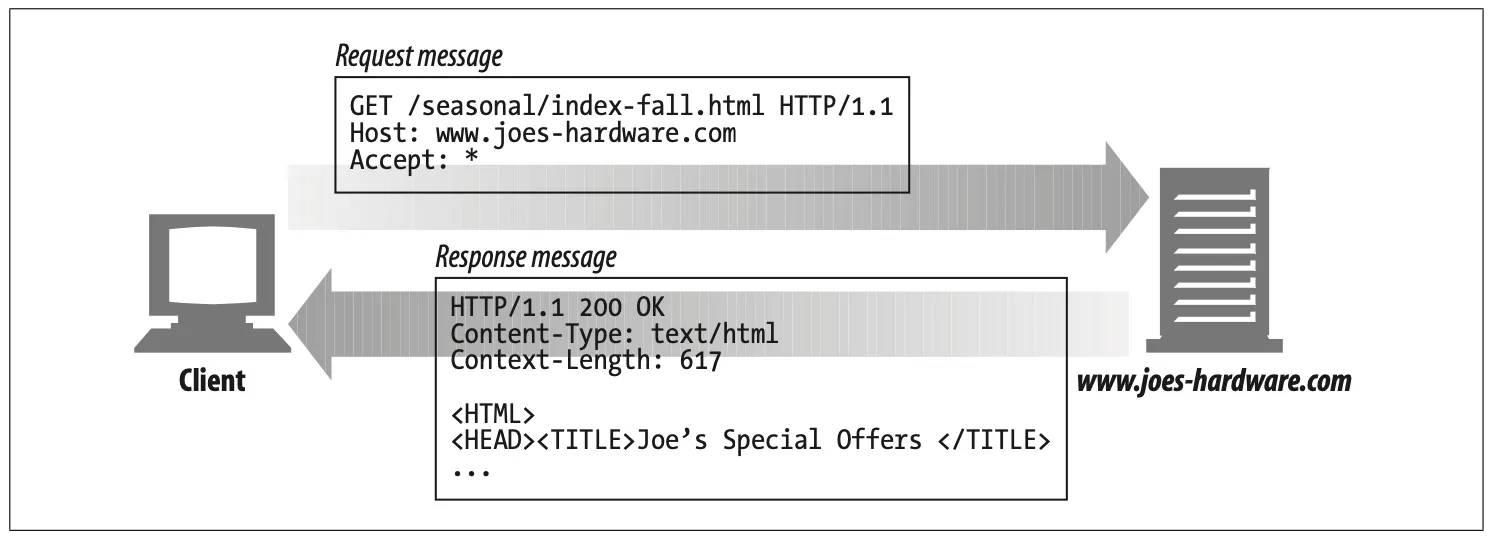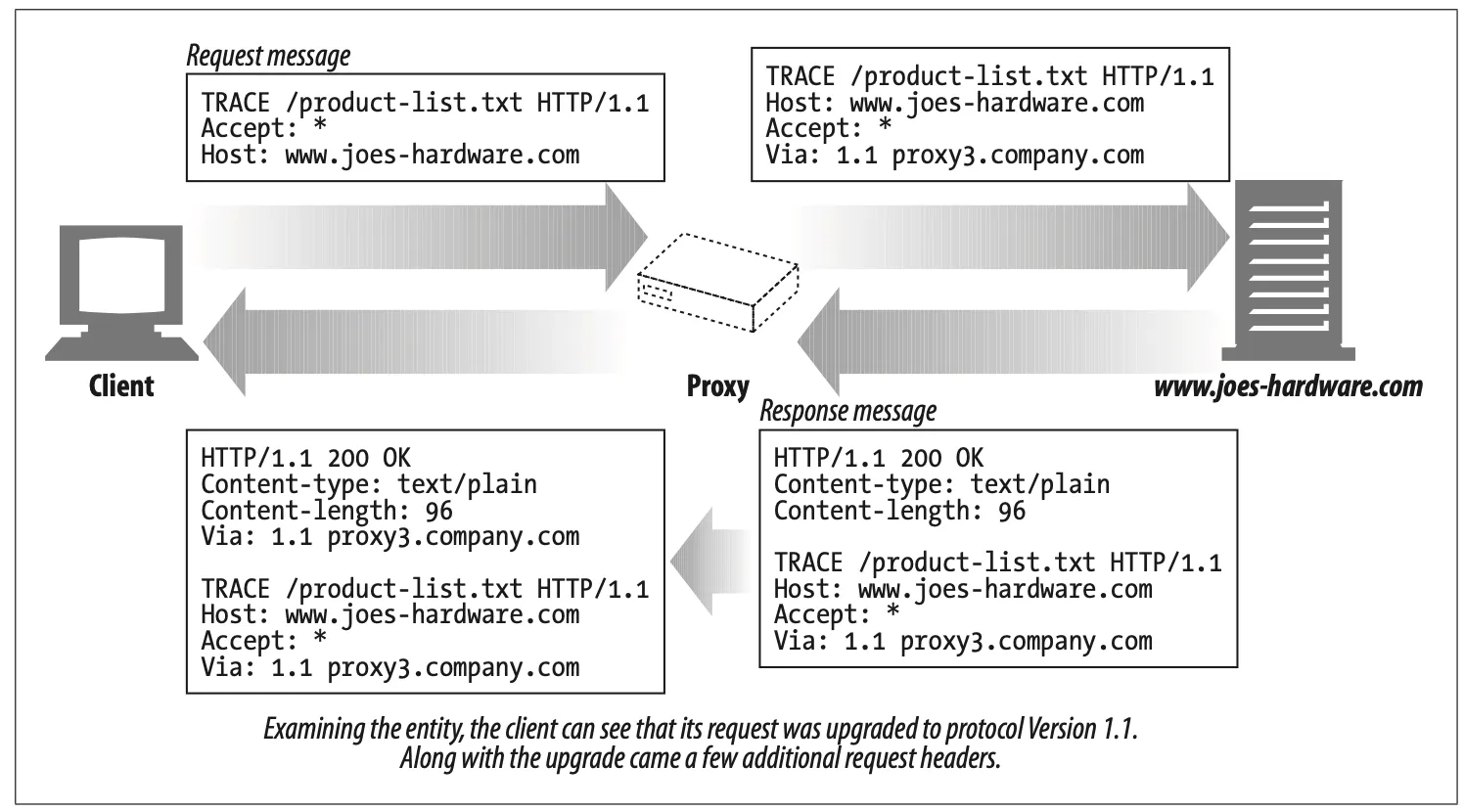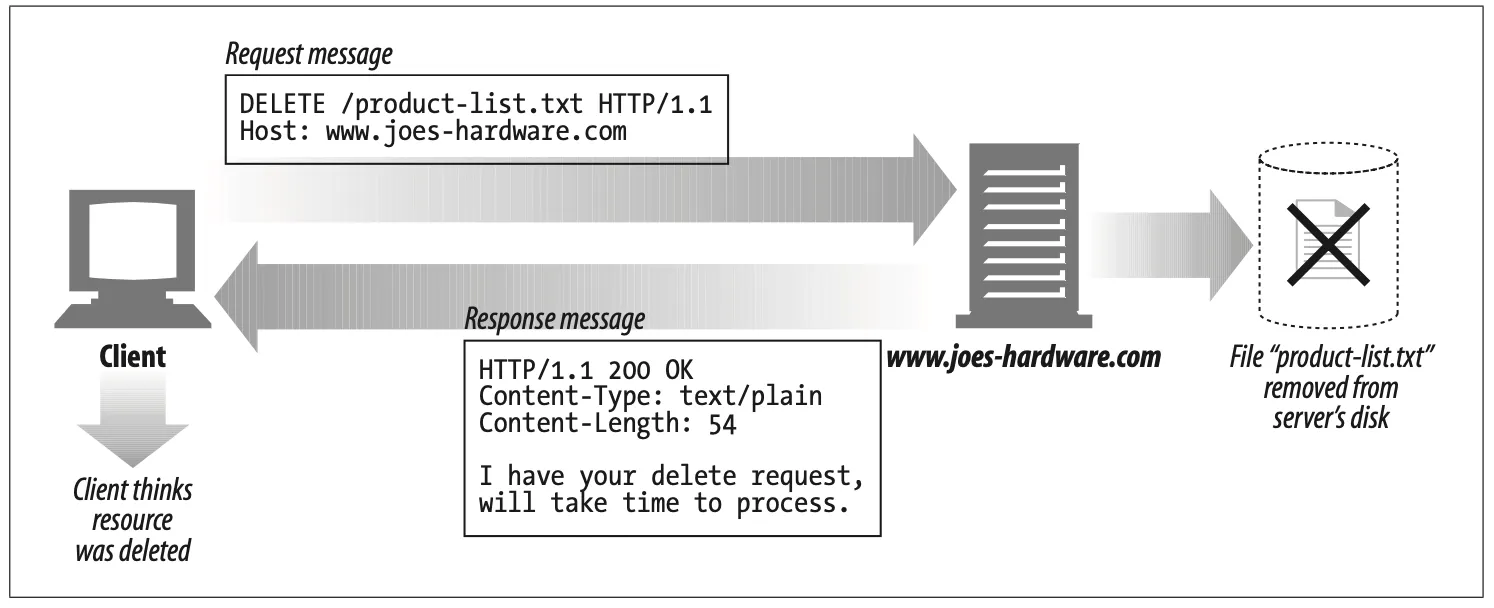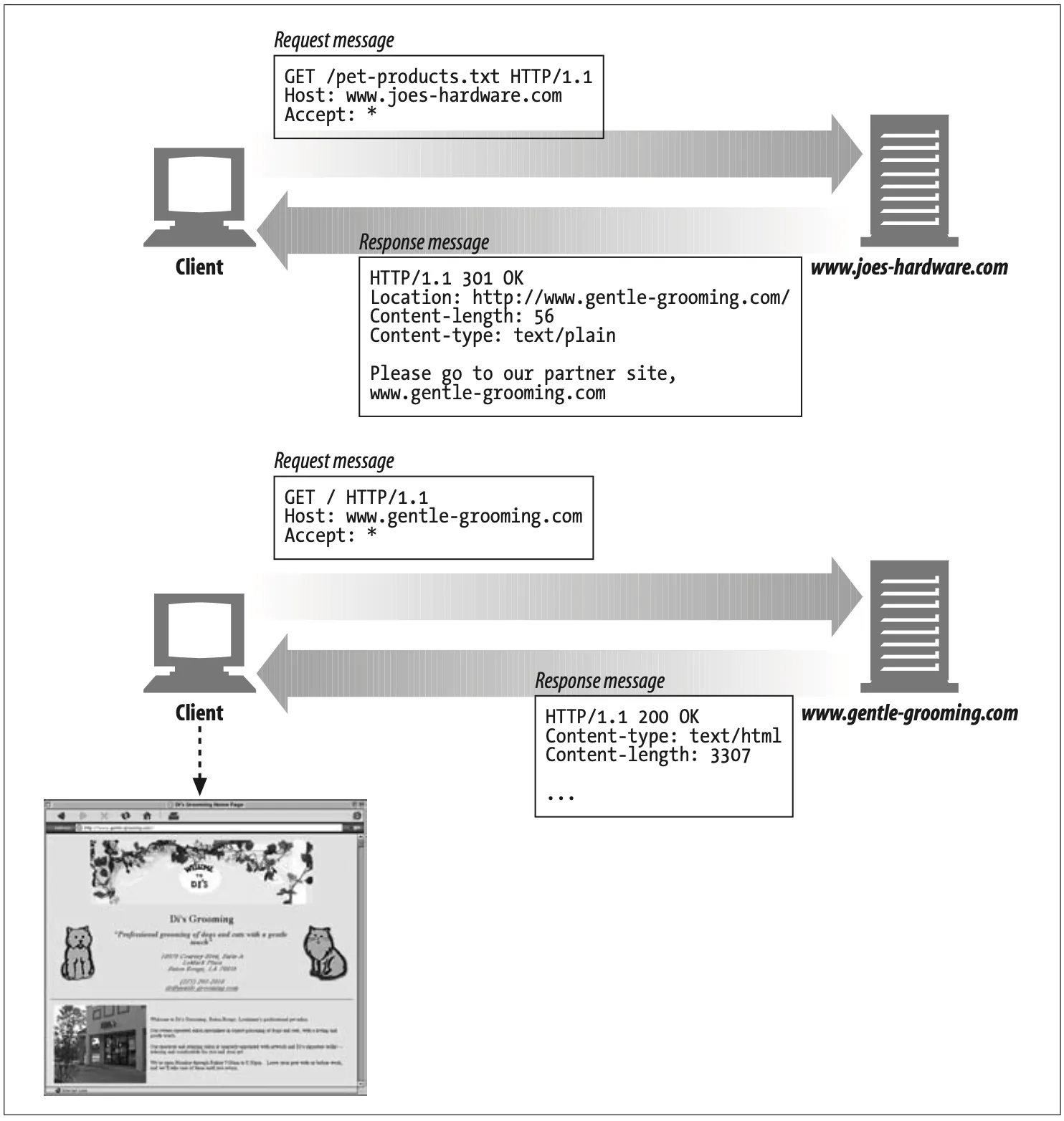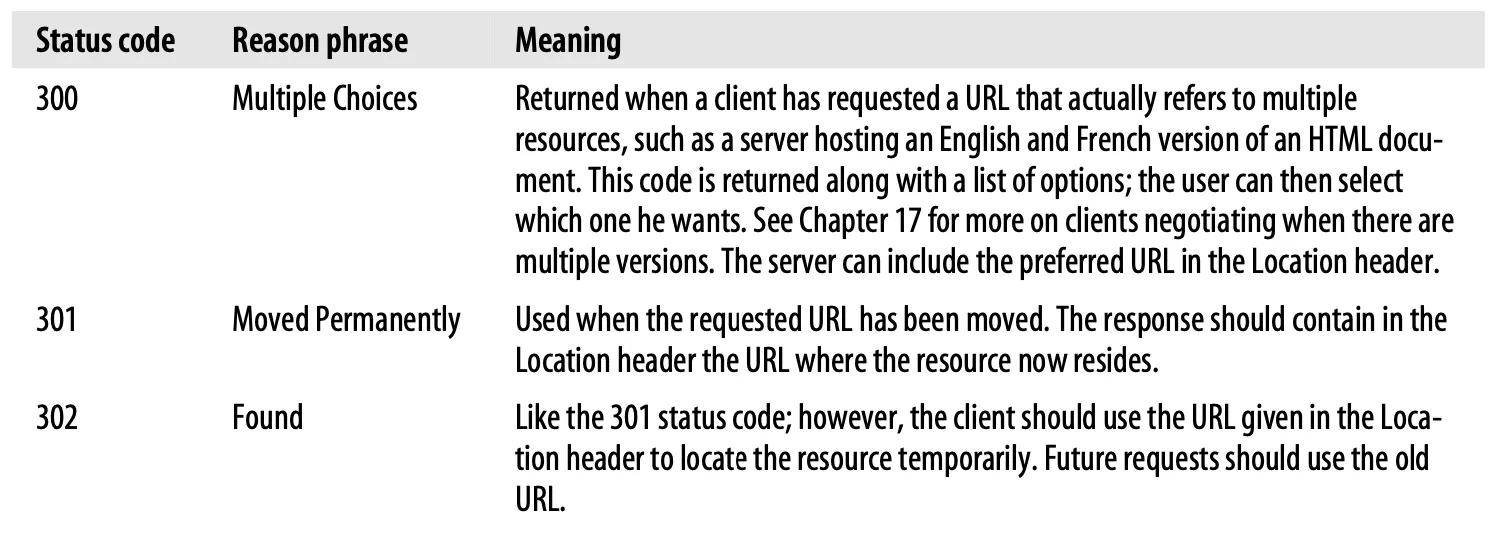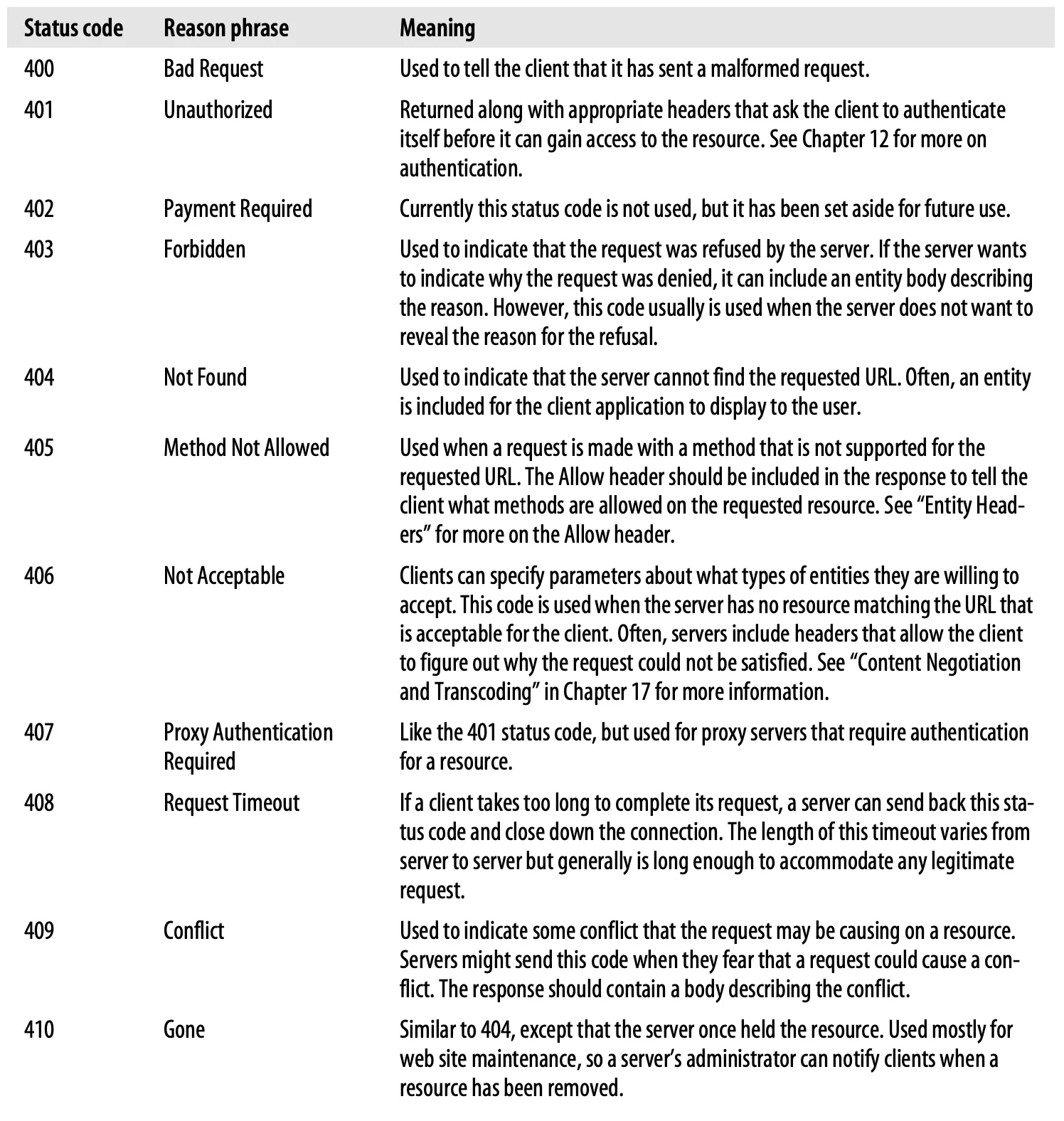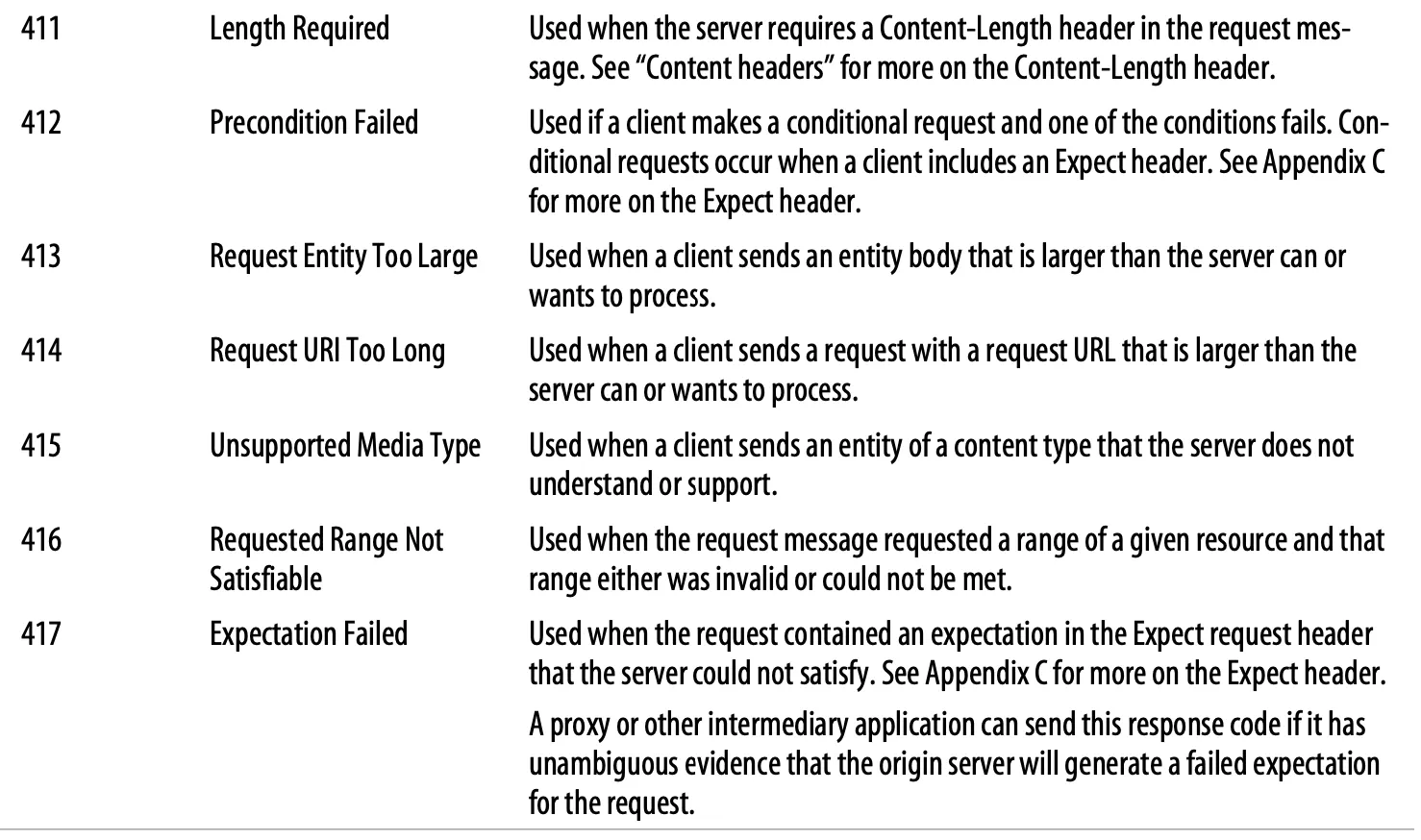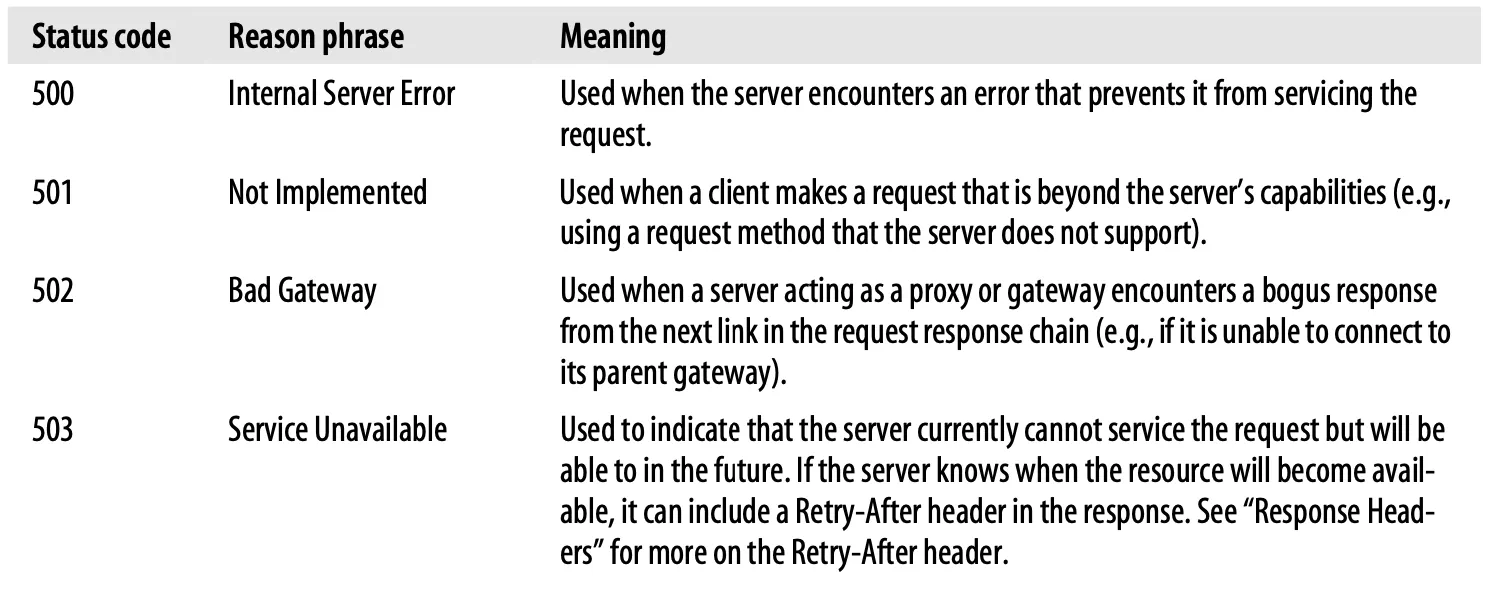•
If HTTP is the Internet's courier, HTTP messages are the pacakages it uses to move things around.
•
This chapter tells you about HTTP messages — how to ceate them and how to understand them.
•
In prticular, you'll understand:
◦
How messages flow
◦
The three parts of HTTP messages (start line, headers, and entity body)
◦
The difference between request and response messages
◦
The various functions (methods) that request messages support
◦
The various status codes that are returned with response messages
◦
What the various HTTP headers do
1. The Flow of Messages
•
HTTP messages are the blocks of data sent between HTTP application.
•
These blocks of data begin with some text meta-information decribing the message contents and meaning, followed by optional data.
•
The terms "inbound", "outbound", "upstream", and "downstream" describe message direction.
1.1. Messages Commute Inbound to the Origin Server
•
HTTP uses the terms inbound and outbound to describe transactional direction.
•
Messages travel inbound to the origin server, and when their work is done, they travel outbound back to the user agent.
Figure 3-1. Messages travel inbound to the origin server and outbound back to the client
1.2. Messages Flow Downstream
•
All message flow downstream, regardless of whether they are request messages or responses message.
•
The sender of any message is upstream of the receiver.
•
The receiver of any message is downstream of the sender.
Figure 3-2. All messages flow downstream
2. The Part of a Message
•
HTTP message contains either a request from a client or response from a server.
•
They consist of three parts:
1.
a start line describing the the message
2.
a block of headers containing attributes
3.
an optional body containing data.
Figure 3-3. Three parts of an HTTP message
•
The start line and headers are just ASCII text, broken up by lines.
•
Each line ends with a two-character end-of-line sequence, consisting of a carriage return (ASCII 13) and a line-feed character (ASCII 10).
◦
Carriage Return(CR) - \r
◦
Line-Feed(LF) - \n
•
This end-of-line sequence is written "CRLF".
•
Some older or broken HTTP applications do not always send both carriage return and line feed.
•
The entity body or message body (or just plain "body") is simply an optional chunk of data.
•
Unlike the start line and headers, the body can contain text or binary data or can be empty.
2.1. Message Syntax
•
All HTTP messages fall into two types: request messages and response messages.
•
Both request and response messages have the same basic message structure.
•
Request messages request an action from a web server.
•
Response messages carry results of a request back to client.
•
method
The action that the client wants the server to perform on the resource. It is a single word, like "GET", "HEAD", or "POST".
•
request-URL
A complete URL naming the requested resource, or the path component of the URL. If you are talking directly to the server, the path component of the URL is usually okay as long as it is the absolute path to the resource — the server can assume ifself as the host/port of the URL.
•
version
The version of HTTP that the message is using. Its format looks like:
HTTP/<major>.<minor>
where major and minor both are integers.
•
status-code
A three-digit number describing what happened during the request. The first digit of each code decribes the general class of status ("success", "error", etc.).
•
reason-phrase
A human-readable version of the numeric status code, consisting of all the text until the end-of-line sequence. The reason phrase is meant solely for human consumption, so, for example, response lines containing "HTTP/1.0 200 NOT OK" and "HTTP/1.0 200 OK" should be treated as equivalent success indications, despite the reason phrases suggesting otherwise.
•
headers
Zero or more headers, each of which is a name, followed by a colon (:), followed by optional whitespace, followed by a value, followed by a CRLF. The headers are terminated by a blank line (CRLF), marking the end of the list of headers and the beginning of the entity body.
Note that a set of HTTP headers should always end in a blank line (bare CRLF), even if there are no headers and even if there is no entity body. Historically, however, many clients and server (mistakenly) omitted the final CRLF if there was no entity body.
•
entity-body
The entity body contains a block of artitrary data. Not all messages contain entity bodies, so sometimes a message terminates with a bare CRLF.
Figure 3-5. Example request and response messages
2.2. Start Lines
•
All HTTP messages begin with a start line.
•
The start line for a request messages say what to to.
•
The start line for a response message says what happend.
Request line
•
The start line for a request messages, or request line, contains a method describing what operation the server should perform and a reqeuest URL describing the resource on which to perform the method.
•
The request line also includes an HTTP version which tell the server what dialect of HTTP the client is speaking.
•
All of these fields are separated by whitespace.
•
Prior to HTTP/1.0, request lines were not required to contain an HTTP version.
Response line
•
Response messages carry status information and any resulting data from an operation back to a client.
•
The start line for a response message, or response line, contains the HTTP version that the response message is using, a numeric status code, and a textual reason phrase describing the status of the operation.
•
All these fields are separated by whitespace.
•
Prior to HTTP/1.0, responses were not required to contain a response line.
Methods
•
The method begins the start line of requests, telling the server what to do.
•
The HTTP specifications have defined a set of common request methods.
◦
The GET method gets a document from a server
◦
The POST method sends data to a server for processing
◦
The OPTIONS method determines the general capabilites of a web server or the capabilities of a web server for a specific resource.
•
Note that some methods have a body in the request message, and other methods have bodyless requests.
Table 3-1. Common HTTP methods
•
Furthermore, because HTTP was designed to be easily extensible, other servers may implement their own request methods in addition to these.
•
These additional methods are called extension methods, because they extend the HTTP specification.
Status codes
•
As methods tell the server what to do, status codes tell the client what happened.
•
Both a numeric and a human-readable status are returned.
•
The numeric code makes error processing easy for programs, while the reason phrase is easily understood by humans.
•
The different status codes are grouped into classes by their three-digit numeric codes
Table 3-2. Status code classes
•
Current versions of HTTP define only a few codes for each status category.
•
As the protocol evolves, more status codes will be defined officially in the HTTP specification.
•
If you receive a status code that you don't recognize, chances are someone has defined it as an extension to the current protocol.
•
You should treat it as a general member of the class whose range it falls into.
Reason phrase
•
It provides a textual explanation of the status code.
•
Reason phrases are paired one-to-one with status codes.
•
The reason phrase provides a human-readable version of the status code that application developers can pass along to their users to indicate what happened during the request.
•
The HTTP specification does not provide any hard and fast rules for what reason phrases should look like.
Version numbers
•
Version numbers appear in both request and response message start lines in the format HTTP/x.y.
•
They provide a means for HTTP applications to tell each other what version of the protocol they conform to.
•
Version numbers are intended to provide applications speaking HTTP with a clue about each other’s capabilities and the format of the message.
•
The version number indicates the highest version of HTTP that an application supports.
•
In some cases this leads to confusion between applications, because HTTP/1.0 applications interpret a response with HTTP/1.1 in it to indicate that the response is a 1.1 response, when in fact that’s just the level of protocol used by the responding application.
•
Note that version numbers are not treated as fractional numbers. Each number in the version (for example, the “1” and “0” in HTTP/1.0) is treated as a separate number.
•
For example, HTTP/2.22 is a higher version than HTTP/2.3, because 22 is a larger number than 3.
2.3. Headers
•
Following the start line comes a list of zero, one, or many HTTP header fields.
•
HTTP header fields add additional information to request and response messages.
•
They are basically just lists of name/value pairs.
Header classifications
•
The HTTP specification defines several header fields.
•
Applications also are free to invent their own home-brewed headers.
•
HTTP headers are classified into:
◦
General headers
Can appear in both request and response messages
◦
Request headers
Provide more information about the request
◦
Response headers
Provode more information about the response
◦
Entity headers
Describe body size and contents, or the resource itself.
◦
Extenstion headers
New headers that are not defined in the specification.
•
Each HTTP header has a simple syntax: a name, followed by a colon (:), followed by optional whitespace, followed by the field value, followed by a CRLF.
Table 3-4. Common header examples
Header continuation lines
•
Long header lines can be made more readable by breaking them into multiple lines, preceding each extra line with at least one space or tab character.
2.4. Entity Bodies
•
The third part of an HTTP message is the optional entity body.
•
Entity bodies are the payload of HTTP messages.
•
HTTP messages can carry many kinds of digital data: images, video, HTML documents, software applications, credit card transactions, electronic mail, and so on.
3. Methods
•
Note that not all methods are implemented by every server.
•
To be compliant with HTTP Version 1.1, a server need implement only the GET and HEAD methods for its resources.
3.1. Safe Methods
•
HTTP defines a set of methods that are called safe methods.
•
The GET and HEAD methods are said to be safe, meaning that no action should occur as a result of an HTTP request that uses either the GET or HEAD method.
•
By no action, we mean that nothing will happen on the server as a result of the HTTP request.
Example
•
In this case, the action is your credit card being charged for your purchase.
•
There is no guarantee that a safe method won’t cause an action to be performed (in practice, that is up to the web developers).
•
Safe methods are meant to allow HTTP application developers to let users know when an unsafe method that may cause some action to be performed is being used.
3.2. GET
•
GET is the most common method.
•
It usually is used to ask a server to send a resource.
•
HTTP/1.1 requires servers to implement this method.
Figure 3-7. GET example
3.3. HEAD
•
The HEAD method behaves exactly like the GET method, but the server returns only the headers in the response.
•
No entity body is ever returned.
•
This allows a client to inspect the headers for a resource without having to actually get the resource.
•
Using HEAD, you can:
◦
Find out about a resource (e.g., determine its type) without getting it.
◦
See if an object exists, by looking at the status code of the response.
◦
Test if the resource has been modified, by looking at the headers.
•
Server developers must ensure that the headers returned are exactly those that a GET request would return.
•
The HEAD method also is required for HTTP/1.1 compliance.
Figure 3-8. HEAD example
3.4. PUT
•
The PUT method writes documents to a server, in the inverse of the way that GET reads documents from a server.
Figure 3-9. PUT example
•
The semantics of the PUT method are for the server to take the body of the request and either use it to create a new document named by the requested URL or, if that URL already exists, use the body to replace it.
•
Because PUT allows you to change content, many web servers require you to log in with a password before you can perform a PUT.
3.5. POST
•
The POST method was designed to send input data to the server.
Figure 3-10. POST example
POST is used to send data to a server. PUT is used to deposit data into a resource on the server (e.g., a file).
3.6. TRACE
•
The TRACE method allows clients to see how its request looks when it finally makes it to the server.
•
The server at the final leg of the trip bounces back a TRACE response, with the virgin request message it received in the body of its response.
•
A client can then see how, or if, its original message was mugned or modified along the request/reponse chain of any intervening HTTP applications.
•
The TRACE method is used primarily for diagnostics; i.e., verifying that requests are going through the request/response chain as intended.
•
It’s also a good tool for seeing the effects of proxies and other applications on your requests.
•
No entity body can be sent with a TRACE request.
•
The entity body of the TRACE response contains, verbatim, the request that the responding server received.
Figure 3-11. TRACE example
3.7. OPTIONS
•
The OPTIONS method asks the server to tell us about the various supported capabilities of the web server.
•
You can ask a server about what methods it supports in general or for particular resources.
•
This provides a means for client applications to determine how best to access various resources with out actually having to access them.
Figure 3-12. OPTIONS example
3.8. DELETE
•
The DELETE method asks the server to delete the resources specified by the request URL.
•
However, the client application is not guaranteed that the delete is carried out.
•
This is because the HTTP specification allows the server to override the request without telling the client.
Figure 3-13. DELETE example
3.9. Extension Methods
•
HTTP was designed to be field-extensible, so new features wouldn’t cause older software to fail.
•
Extension methods are methods that are not defined in the HTTP/1.1 specification.
•
They provide developers with a means of extending the capabilities of the HTTP services their servers implement on the resources that the servers manage.
•
If you define an extension method, it’s likely not to be understood by most HTTP applications.
•
Likewise, it’s possible that your HTTP applications could run into extension methods being used by other applications that it does not understand.
•
In these cases, it is best to be tolerant of extension methods.
•
Proxies should try to relay messages with unknown methods through to downstream servers if they are capable of doing that without breaking end-to-end behavior.
•
Otherwise, they should respond with a 501 Not Implemented status code.
•
Dealing with extension methods (and HTTP extensions in general) is best done with the old rule, “be conservative in what you send, be liberal in what you accept.”
4. Status Codes
•
The status codes provide an easy way for clients to understand the results of their transactions.
•
We also list example reason phrases, though there is no real guidance on the exact text for reason phrases.
4.1. 100-199: Informational Status Codes
•
HTTP/1.1 introduced the informational status codes to the protocol.
•
It’s intended to optimize the case where an HTTP client application has an entity body to send to a server but wants to check that the server will accept the entity before it sends it.
Clients and 100 Continue
•
If a client is sending an entity to a server and is willing to wait for a 100 Continue response before it sends the entity, the client needs to send an Expect request header (see Appendix C) with the value 100-continue.
•
If the client is not sending an entity, it shouldn’t send a 100-continue Expect header, because this will only confuse the server into thinking that the client might be sending an entity.
•
100-continue, in many ways, is an optimization.
•
A client application should really use 100-continue only to avoid sending a server a large entity that the server will not be able to handle or use.
•
Because of the initial confusion around the 100 Continue status (and given some of the older implementations out there), clients that send an Expect header for 100-continue should not wait forever for the server to send a 100 Continue response.
•
After some timeout, the client should just send the entity.
•
In practice, client implementors also should be prepared to deal with unexpected 100 Continue responses (annoying, but true).
•
Some errant HTTP applications send this code inappropriately.
Servers and 100 Continue
•
If a server receives a request with the Expect header and 100-continue value, it should respond with either the 100 Continue response or an error code.
•
Servers should never send a 100 Continue status code to clients that do not send the 100-continue expectation.
•
If for some reason the server receives some (or all) of the entity before it has had a chance to send a 100 Continue response, it does not need to send this status code, because the client already has decided to continue. When the server is done reading the request, however, it still needs to send a final status code for the request.
Proxies and 100 Continue
•
If the proxy either knows that the next-hop server is HTTP/1.1-compliant or does not know what version the next-hop server is compliant with, it should forward the request with the Expect header in it.
•
If it knows that the next-hop server is compliant with a version of HTTP earlier than 1.1, it should respond with the 417 Expectation Failed error.
4.2. 200-299: Success Status Codes
•
When clients make requests, the requests usually are successful.
•
Servers have an array of status codes to indicate success, matched up with different types of requests.
Table 3-7. Success status codes and reason phrases
4.3. 300-399: Redirection Status Codes
•
The redirection status codes either tell clients to use alternate locations for the resources they’re interested in or provide an alternate response instead of the content.
•
If a resource has moved, a redirection status code and an optional Location header can be sent to tell the client that the resource has moved and where it can now be found.
•
This allows browsers to go to the new location transparently, without bothering their human users.
Figure 3-14. Redirected request to new location
•
Some of the redirection status codes can be used to validate an application’s local copy of a resource with the origin server.
Example
•
In general, it’s good practice for responses to non-HEAD requests that include a redirection status code to include an entity with a description and links to the redirected URL(s).
Figure 3-15. Request redirected to use local copy
Table 3-8. Redirection status codes and reason phrases
4.4. 400-499: Client Error Status Codes
•
Sometimes a client sends something that a server just can’t handle, such as a badly formed request message or, most often, a request for a URL that does not exist.
•
Many of the client errors are dealt with by your browser, without it ever bothering you. A few, like 404, might still pass through.
Table 3-9. Client error status codes and reason phrases
4.5. 500-599: Server Error Status Codes
•
Sometimes a client sends a valid request, but the server itself has an error.
◦
This could be a client running into a limitation of the server or an error in one of the server’s subcomponents, such as a gateway resource.
Table 3-10. Server error status codes and reason phrases
5. Headers
•
Headers and methods work together to determine what clients and servers do.
•
There are headers that are specific for each type of message and headers that are more general in purpose, providing information in both request and response messages.
•
Headers fall into five main classes:
◦
General headers
These are generic headers used by both clients and servers. They serve general purposes that are useful for clients, servers, and other applications to supply to one another.
Date: Tue, 3 Oct 1974 02:16:00 GMT
◦
Request headers
As the name implies, request headers are specific to request messages. They provide extra information to servers, such as what type of data the client is willing to receive. For example, the following Accept header tells the server that the client will accept any media type that matches its request:
Accept: /
◦
Response headers
Response messages have their own set of headers that provide information to the client (e.g., what type of server the client is talking to).
Server: Tiki-Hut/1.0
◦
Entity headers
Entity headers refer to headers that deal with the entity body. For instance, entity headers can tell the type of the data in the entity body.
Content-Type: text/html; charset=iso-latin-1
◦
Extension headers
Extension headers are nonstandard headers that have been created by application developers but not yet added to the sanctioned HTTP specification. HTTP programs need to tolerate and forward extension headers, even if they don’t know what the headers mean.
5.1. General Headers
•
Some headers provide very basic information about a message.
•
These headers are called general headers.
•
They are the fence straddlers, supplying useful information about a message regardless of its type.
•
For example, whether you are constructing a request message or a response message, the date and time the message is created means the same thing.
Table 3-11. General informational headers
General caching headers
•
HTTP/1.0 introduced the first headers that allowed HTTP applications to cache local copies of objects instead of always fetching them directly from the origin server.
Table 3-12. General caching headers
5.2. Request Headers
•
Request headers are headers that make sense only in a request message.
•
They give information about who or what is sending the request, where the request originated, or what the preferences and capabilities of the client are.
•
Servers can use the information to try to give the client a better response.
Table 3-13. Request informational headers
Accept headers
•
Accept headers give the client a way to tell servers their preferences and capabilities: what they want, what they can use, and, most importantly, what they don’t want.
•
Servers can then use this extra information to make more intelligent decisions about what to send. Accept headers benefit both sides of the connection.
Table 3-14. Accept headers
Conditional request headers
•
Using conditional request headers, clients can put such restrictions on requests, requiring the server to make sure that the conditions are true before satisfying the request.
•
For instance, if the client already has a copy of a document, it might want to ask a server to send the document only if it is different from the copy the client already has.
Table 3-15. Conditional request headers
Request security headers
•
HTTP natively supports a simple challenge/response authentication scheme for requests.
•
It attempts to make transactions slightly more secure by requiring clients to authenticate themselves before getting access to certain resources.
Table 3-16. Request security headers
Proxy request headers
•
As proxies become increasingly common on the Internet, a few headers have been defined to help them function better.
Table 3-17. Proxy request headers
5.3. Response Headers
•
Response messages have their own set of response headers. Response headers provide clients with extra information, such as who is sending the response, the capabilities of the responder, or even special instructions regarding the response.
•
These headers help the client deal with the response and make better requests in the future.
Table 3-18. Response informational headers
Negotiation headers
•
HTTP/1.1 provides servers and clients with the ability to negotiate for a resource if multiple representations are available.
•
For instance, when there are both French and German translations of an HTML document on a server.
Table 3-19. Negotiation headers
Response security headers
•
You’ve already seen the response security headers, which are basically the response side of HTTP’s challenge/response authentication scheme.
Table 3-20. Response security headers
5.4. Entity Headers
•
There are many headers to describe the payload of HTTP messages.
•
Because both request and response messages can contain entities, these headers can appear in either type of message.
•
Entity headers provide a broad range of information about the entity and its content, from information about the type of the object to valid request methods that can be made on the resource.
Table 3-21. Entity information headers
Content headers
•
The content headers provide specific information about the content of the entity, revealing its type, size, and other information useful for processing it.
•
For instance, a web browser can look at the content type returned and know how to display the object.
Table 3-22. Content headers
Entity caching headers
•
The entity caching headers provide information about the entity being cached.
•
For example, information needed to validate whether a cached copy of the resource is still valid and hints about how better to estimate when a cached resource may no longer be valid.
Table 3-23. Entity caching headers

